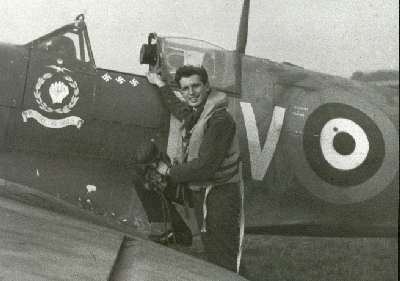

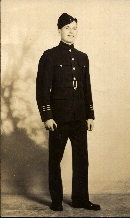 James Henry "Jimmy" Whalen was born in Vancouver, British Columbia on April 23rd, 1920. He graduated from Kitsilano High School in June, 1938. As a teenager he showed a keen interest in aerial warfare, reading any books about WW I aces and modern fighter planes that he could get his hands on. He joined the Seaforth Highlanders Army Cadets in 1937 in an effort to gain military experience, however, his dream was to be a fighter pilot in the air force. World War II began in 1939 and in 1940 the Royal Canadian Air Force realized a need for future aircrew and formed the Air Force Cadets. The first squadron was started in Vancouver (known today as the 111 Pegasus SquadronRoyal Canadian Air Cadets) . Jimmy quickly transferred to this new squadron and was named its first Wing Commander. At the time he was a first year student at the University of British Columbia. In 1940 the RCAF waived its' requirements for pilots to be university graduates, and on June 26th, 1940 Jimmy enlisted.
James Henry "Jimmy" Whalen was born in Vancouver, British Columbia on April 23rd, 1920. He graduated from Kitsilano High School in June, 1938. As a teenager he showed a keen interest in aerial warfare, reading any books about WW I aces and modern fighter planes that he could get his hands on. He joined the Seaforth Highlanders Army Cadets in 1937 in an effort to gain military experience, however, his dream was to be a fighter pilot in the air force. World War II began in 1939 and in 1940 the Royal Canadian Air Force realized a need for future aircrew and formed the Air Force Cadets. The first squadron was started in Vancouver (known today as the 111 Pegasus SquadronRoyal Canadian Air Cadets) . Jimmy quickly transferred to this new squadron and was named its first Wing Commander. At the time he was a first year student at the University of British Columbia. In 1940 the RCAF waived its' requirements for pilots to be university graduates, and on June 26th, 1940 Jimmy enlisted.
He became one of the first candidates of the new Commonwealth Air Training Plan and trained in Ottawa, receiving his wings on January 25th, 1941. Rated highly, he had received a commission as a Pilot Officer, only to have it rescinded after he was caught displaying his flying prowess by scooting under a local bridge (Jimmy flew under the Ottawa/Hull bridge, pulled up hard into a loop then completed the loop by flying under the bridge again. A witness to the display took down the Harvard's number and reported it to the base). In March of 1941 he was posted to the #2 A.A.C.U. in Gosport, England. From there, in June of 1941, he was posted to # 57 O.T.U in Wrexham, Wales. Here his dream became reality when he began operational training on the Supermarine Spitfire MK I. He quickly showed his potential as a fighter pilot and was rated "Above average" by his instructors.
While the Operational Training Units were not in the combat area, they were still a dangerous place to be. Three of Jimmy's classmates had already been killed while training in Canada. On June 26th, his first anniversary in the RCAF, two friends, Pilot Officer Milmine and Sgt. Womack were killed while practicing dogfighting. On July the 7th another friend, Sgt Goldberg was killed in a mid-air collision. Finally, on the 20th of July, just two days before graduating to a fighter squadron Pilot Officer (his rank now restored), Jimmy Whalen was practicing formation flying with Sgt. Kempling and Sgt. Beaton when the latter two collided and were killed. The entry in his log book reads: "Beaton and Kempling killed in formation with me. Mid-air collision. It was a god damn shame." Without seeing a minute in combat, he had lost 8 fellow pilots.
On August 1st, 1941 Jimmy was posted to 129 (Mysore) Squadron, an RAF unit based at Leconfield (he would fly as a Canadian in the RAF for the rest of his service). It was not a leisurely transition from the OTU. The next day he was sent up on his first combat sortie, flying one of the squadron's aging Spitfire Mk Is. On that mission Pilot Officer Cunliffe downed the squadron's first enemy aircraft, a Junkers Ju-88. On the 28th of August the squadron transferred to West Hampnett, Sussex (part of the Tangmere Wing) to relieve 610 Squadron and take over their new Spitfire Mk Vs. Jimmy worked hard to become familiar with the new planes and listened intently to the advice he got from his squadron mates, many of whom were veterans of the Battle of Britain. His chance to put all this training to good use came soon.
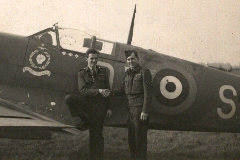 On September 17th, 1941 129 Squadron was on a fighter sweep to Fruges, France when they ran into a flight of Luftwaffe Me-109s. In the ensuing dogfight Jimmy downed an Me-190E and an Me-109F. Unfortunately the dogfight consumed much of his fuel and he crashed landed, on the English coast, at Hurstpierpont. He had to hitch a ride back to the base before he could be congratulated. Four days later, on a sweep over Gosnay, France, near the Pas de Calais, Jimmys squadron ran into a large group of enemy fighters. In the ensuing melee Squadron Leader Armitage and friend Lloyd MacDonald were both shot down (Armitage survived but was taken prisoner.) Jimmy evened the score by downing another Me-109E and damaging a second. A few days later he commemorated the events with a photo taken in front of his newly customized Spitfire with his good friend and Squadron mate Ray Sherk. Jimmy had known Ray since their days at the OTU ( Ray had been one of Sgt. Goldbergs pallbearers.)
On September 17th, 1941 129 Squadron was on a fighter sweep to Fruges, France when they ran into a flight of Luftwaffe Me-109s. In the ensuing dogfight Jimmy downed an Me-190E and an Me-109F. Unfortunately the dogfight consumed much of his fuel and he crashed landed, on the English coast, at Hurstpierpont. He had to hitch a ride back to the base before he could be congratulated. Four days later, on a sweep over Gosnay, France, near the Pas de Calais, Jimmys squadron ran into a large group of enemy fighters. In the ensuing melee Squadron Leader Armitage and friend Lloyd MacDonald were both shot down (Armitage survived but was taken prisoner.) Jimmy evened the score by downing another Me-109E and damaging a second. A few days later he commemorated the events with a photo taken in front of his newly customized Spitfire with his good friend and Squadron mate Ray Sherk. Jimmy had known Ray since their days at the OTU ( Ray had been one of Sgt. Goldbergs pallbearers.)
Jimmy described the engagements in a letter to his family:
"I was on a sweep leading green section when I saw a ME 109F about to attack my number two. I turned after him and shot him down and then lost our squadron. I was going to head for England when I saw a squadron above about ten to twenty miles inside France. I didn't know who they were so I headed towards them. When I was close enough I saw that they were ME 109E's. About 12-15 flying in formation . I attacked shooting down the first Gerry. I missed the next then damaged a third, who might have crashed, and was going to shoot at a fourth when my ammunition was finished. I could see nothing but Gerrys around me and I beat it for England as fast as I could go doing all kinds of queer maneuvers to keep the ME 109's away from me. That was my first fight and yesterday I had my second. We were on a sweep just crossing the coast when 90 + ME 109's attacked us. I had a couple of unsuccessful brushes and being separated from the rest my number two and I started to fight our way home. We were attacked by four ME 109's out over the Channel, we took on two apiece but mine headed for France. I lost my number two then and was headed for home when I saw two of three ME 109's that were attacking a damaged Spitfire. I attacked them shooting the first down and damaging the other and was then attacked by the third ME 109. He hit out for France after a slight scrap and I returned to base. The pilot of the damaged Spitfire said he thought I was an angel from heaven when he saw me coming to help him."
On October 20th he was aloft again when the squadron made a strike on Le Havre and Dieppe. Once there they ran into heavy anti-aircraft fire from a German Flak ship. Seeking to suppress the fire Jimmy dove straight for the ship. Although he took a number of hits he continued to pepper the ship with cannon and machine gun fire until it was put out of action, listing badly to the starboard. He continued with 129 squadron, until December, when history changed his fate. On December 7th, 1941 the Japanese attacked Pearl Harbour, Hawaii and other Southeast Asian targets. Suddenly British interests in Asia were threatened, and there was a desperate need to send experienced fighter pilots to defend India and Burma. Jimmy volunteered to be one of them.
Three weeks later on January 3rd, 1942 Jimmy found himself as a co-pilot on a DC-3 flying across Africa on its way to India. He arrived in Port Sudan on February 6th, where he started familiarization flying on a Hawker Hurricane 2b and a Curtiss Kittyhawk. These were a considerable step down in performance from the Spitfire Vb. While there he met another pilot waiting for assignment to a squadron and they struck up an immediate friendship. Don Geffene was an American from Pacific Palisades California who had joined the RAF early in the war served in England with 71 Squadron, one of the famed "Eagle Squadrons". On February 22nd, Jimmy and Don were assigned to 30 Squadron, who had just finished efforts in the desert war. On the day they arrived Jimmy was quickly shown to the cockpit of a Kittyhawk (after only 3 hours flying them) and sent off on an anti-submarine patrol over the Red Sea. On February 27th the squadron was placed, aircraft and all, onto the H.M.S. Indomitable and shipped to their new base, at Colombo, Ceylon.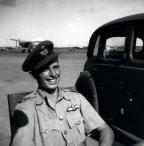
On March 6th the squadron disembarked the aircraft carrier and set up just outside of Colombo at Ratmalana. There was a large Royal Navy fleet stationed at Colombo, and it was the squadron's duty to defend it. Also posted to Colombo with them was the only Canadian squadron in the Far east at the time, 413 Squadron RCAF, who were operating Catalina flying boats. Squadron leader Len Birchall and his men were tasked with patrolling the ocean watching for a Japanese attack. On March 4th Birchall and his crew were nearing the end of an extended patrol when they spotted a Japanese carrier task force steaming for Ceylon. They barely had time to radio back to Colombo before they were swarmed by Zeros and shot down. At the time it was assumed that Squadron Leader Birchall had died, sacrificing himself for Ceylon. He became an instant hero, known as " The Saviour of Ceylon". Only at the end of the war was it realized that he had survived, been captured, and spent the war in a Japanese prison camp.
On April 5th, 1942 a Japanese strike force under the command of Vice-Admiral Chuichi Nagumo, fresh from their attack on Pearl Harbour, attacked Ceylon with 120 Carrier based air planes. The RAF could field only 40 defending aircraft. These were Fulmars and Hurricanes, which were no match for the swift and maneuverable Zeros of the Imperial Japanese Navy. Jimmy and a number of Canadians serving with 30 Squadron, including Flight Lieutenant Bob Davidson, who was also from Vancouver, were tasked to wade into the onslaught of Japanese planes.
Jimmy flew up over Colombo and started to patrol at 15000 feet. It only took a few minutes to sight a formation of Val (Navy type 99) bombers at about 18000 feet. Jimmy climbed into a position just above them then dove headlong into the enemy planes. In his first pass he downed two of the bombers, passing right through them. Leveling off, he reassessed the situation and found himself once again underneath the bombers but also observing that they were continuing on. So, he decided to give it another go. He climbed once more, set up above the Vals, then dove in again, guns blazing. Another went down in flames. Unfortunately by then a flight of Zeros had observed the action and quickly had Jimmy twisting and turning trying to shake his pursuers. Just when it seemed he was going to fall victim to the Japanese fighters, out of nowhere came Flight Lieutenant Davidson, who fired a burst into the first Zero sending it down. The others panicked and broke off. Jimmy and his flight leader, low on fuel, returned to base. By the end of the action 17 Japanese aircraft had been destroyed. Twenty-seven RAF and FAA (Navy) aircraft had been lost in the battle, with 17 airmen killed and 11 injured (Sadly, one of those killed was Jimmys good friend Don Geffene.) The pilots of 30 Squadron claimed 14 enemy aircraft destroyed, 6 more probably destroyed, and 5 more damaged, out of a total of 19 destroyed, 7 probably destroyed, and 9 damaged in air combat. (Figures from RAF History - The Battle of Ceylon ).
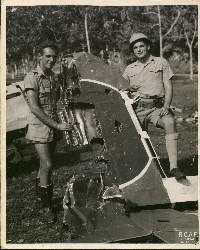 Jimmy's tally was now six confirmed enemy aircraft and that made him an Ace. At a low point in the war, the actions of the pilots were seen as heroic, and a golden opportunity to boost the morale of the homefront. The RCAF dispatched a photographer and reporter from its newspaper. A number of publicity photos were taken at the squadron including some of the new Ace and a comic strip was published.
Jimmy's tally was now six confirmed enemy aircraft and that made him an Ace. At a low point in the war, the actions of the pilots were seen as heroic, and a golden opportunity to boost the morale of the homefront. The RCAF dispatched a photographer and reporter from its newspaper. A number of publicity photos were taken at the squadron including some of the new Ace and a comic strip was published.
Things settled down after the attack and Jimmy and his squadron mates took time to enjoy the life at Colombo. Sgt. Grant "Bish" Bishop from Kelowna, B.C. was Jimmy's greatest friend on the squadron. Bish became "Black Two" Jimmy's wingman and together they were inseparable. They became such close friends that they even signed letters home to Jimmy's sister Joan and his brother Bob(who was an air gunner in North Africa) "from Jimmy and Bish".
Jimmy enjoyed his time at 30 Squadron, but the months rolled on and eventually in December 1942 he was transferred to 17 Squadron under the command of Squadron Leader "Bush Cotton" an Australian. By now there were few Japanese planes in the area and this made improving ones score difficult. For the rest of the war Jimmy would fly as a fighter-bomber pilot, providing ground support to the infantry.
He made many of these sweeps with 17 Squadron. In June of 1943 17 Squadron was moved from Calcutta to Agartala. From there they made a number of sorties against the Japanese in Burma, strafing targets of opportunity, particularly Sampans transporting troops and supplies along the rivers.
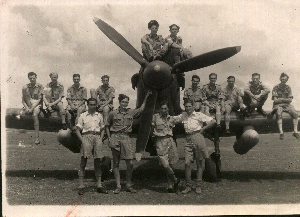 In August he was transferred again, this time to 34 Squadron based at Madras. 34 Squadron was flying the Hawker Hurricane 2c, which had been converted to hold two 250 pound bombs. These planes were referred to as Hurri-Bombers. 34 Squadron's speciality was bombing and strafing enemy troop concentrations, and they did lots of this. In November of 1943 the squadron was moved to a jungle airstrip at Palel, Manipur very close to the Burmese border. From here, with the help of their dedicated and hardworking groundcrew, they flew innumerable sorties against the Japanese. Although there were few Japanese planes, danger from ground fire was extreme (as Typhoon fighter-bomber pilots in Normandy would find out after D-Day).
In August he was transferred again, this time to 34 Squadron based at Madras. 34 Squadron was flying the Hawker Hurricane 2c, which had been converted to hold two 250 pound bombs. These planes were referred to as Hurri-Bombers. 34 Squadron's speciality was bombing and strafing enemy troop concentrations, and they did lots of this. In November of 1943 the squadron was moved to a jungle airstrip at Palel, Manipur very close to the Burmese border. From here, with the help of their dedicated and hardworking groundcrew, they flew innumerable sorties against the Japanese. Although there were few Japanese planes, danger from ground fire was extreme (as Typhoon fighter-bomber pilots in Normandy would find out after D-Day).
The largest land battle in the Asian theater The Battle of the Imphal Plain occurred in March/April of 1944. The Japanese attacked from Burma directly toward Imphal. To the north, the small mountain village of Kohima was attacked by the Japanese 31st division, numbering 15 000 men. The village was defended by approximately 3000 men including the 4th battalion of the Royal West Kents. For 2 weeks battles raged in and around the residence of the British Deputy Commissioner. The defenders were hammered mercilessly.
34 squadron was moved to Dergaon, Assam to provide quicker ground support for the troops. The squadron flew bombing and strafing missions every day, sometimes twice a day, attacking the Japanese positions around Kohima throughout the two week battle. The village was nestled between two mountain ridges, which meant the pilots would have to run a gauntlet of small arms and light anti-aircraft fire while making their strafing and bombing runs. On the 18th of April, 1944 Jimmy was leading 6 of the squadrons Hurri-Bombers on a sortie to relieve the defenders of Kohima. As he entered the area of the Rifle range he and his wingman F/Sgt. Jack Morton ran into very heavy light arms fire:
 We were flying from Dergaon when Jimmy was killed. He led six Hurricanes on an attack on the Rifle Range and I was his No. 2. We bombed in Sections of two and Jimmy and I were first in bombing with two 250lb. Bombs with 11 second delays fitted. I was slightly behind Jimmy and we dropped our bombs at about 50 feet and as we left the target area Jimmy's plane did a barrel roll and crashed. It was a very sad day on the Squadron because he was by far the most popular officer and pilot in both the Officers and Sergeants Mess. We carried out two more attacks that day and on both occasions we looked for his plane but there was nothing to be seen in the dense jungle. (As written in a letter by Jack Morton, April 2000)
We were flying from Dergaon when Jimmy was killed. He led six Hurricanes on an attack on the Rifle Range and I was his No. 2. We bombed in Sections of two and Jimmy and I were first in bombing with two 250lb. Bombs with 11 second delays fitted. I was slightly behind Jimmy and we dropped our bombs at about 50 feet and as we left the target area Jimmy's plane did a barrel roll and crashed. It was a very sad day on the Squadron because he was by far the most popular officer and pilot in both the Officers and Sergeants Mess. We carried out two more attacks that day and on both occasions we looked for his plane but there was nothing to be seen in the dense jungle. (As written in a letter by Jack Morton, April 2000)
Joe Smith, Jimmy's Radio/Radar Technician, describes that day to the Imperial War Museum:
For his actions with the Squadron Jimmy was awarded the Distinguished Flying Cross. He is buried, with the other defenders of Kohima, at the Kohima Commonwealth Military Cemetery.
In 2010 the Battle of Britain Memorial Flight began a rebuild of Hawker Hurricane PZ865 which will now wear a new colour scheme, faithfully replicating Hurricane Mk IIC HW840, coded EG-S, of 34 Squadron, South East Asia Command during 1944, the personal aircraft of Canadian pilot, Flight Lieutenant Jimmy Whalen, DFC.
Clive Rowley narrates Jimmy's story at the BBMF:

34 Squadron Reunion Photo
To contact Bill Whalen please email at queenscowboy@icloud.com
Web page design by Patrick Whalen
And Thanks to
Spencer Trickett - Aviation Art
Our other memorial websites:
Don Geffene
Lawrence Jackson
Lloyd Thomas
George Stanton Gale
The Text of this document may be used freely under the terms of the WP:GFDL
|
|